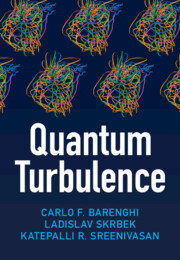Refine search
Actions for selected content:
8126 results in Fluid dynamics and solid mechanics
5 - Theoretical and Numerical Models
-
- Book:
- Quantum Turbulence
- Published online:
- 28 September 2023
- Print publication:
- 19 October 2023, pp 82-109
-
- Chapter
- Export citation
4 - Experimental Methods
-
- Book:
- Quantum Turbulence
- Published online:
- 28 September 2023
- Print publication:
- 19 October 2023, pp 47-81
-
- Chapter
- Export citation
12 - Regimes of Quantum Turbulence
-
- Book:
- Quantum Turbulence
- Published online:
- 28 September 2023
- Print publication:
- 19 October 2023, pp 265-282
-
- Chapter
- Export citation
8 - Turbulence in 3He-B
-
- Book:
- Quantum Turbulence
- Published online:
- 28 September 2023
- Print publication:
- 19 October 2023, pp 157-169
-
- Chapter
- Export citation
2 - Quantum Fluids
-
- Book:
- Quantum Turbulence
- Published online:
- 28 September 2023
- Print publication:
- 19 October 2023, pp 6-19
-
- Chapter
- Export citation
3 - Quantized Vortices
-
- Book:
- Quantum Turbulence
- Published online:
- 28 September 2023
- Print publication:
- 19 October 2023, pp 20-46
-
- Chapter
- Export citation

Quantum Turbulence
-
- Published online:
- 28 September 2023
- Print publication:
- 19 October 2023
ANZ VOLUME 65 ISSUE 1-2 COVER AND FRONT MATTER
-
- Journal:
- The ANZIAM Journal / Volume 65 / Issue 1-2 / January 2023
- Published online by Cambridge University Press:
- 26 September 2023, pp. f1-f2
-
- Article
-
- You have access
- Export citation
EDITORIAL: SPECIAL ISSUE IN HONOUR OF PROFESSOR GRAEME HOCKING
-
- Journal:
- The ANZIAM Journal / Volume 65 / Issue 1-2 / January 2023
- Published online by Cambridge University Press:
- 26 September 2023, pp. 1-2
-
- Article
-
- You have access
- HTML
- Export citation
ANZ VOLUME 65 ISSUE 1-2 COVER AND BACK MATTER
-
- Journal:
- The ANZIAM Journal / Volume 65 / Issue 1-2 / January 2023
- Published online by Cambridge University Press:
- 26 September 2023, pp. b1-b8
-
- Article
-
- You have access
- Export citation
ANZ VOLUME 64 ISSUE 4 COVER AND BACK MATTER
-
- Journal:
- The ANZIAM Journal / Volume 64 / Issue 4 / October 2022
- Published online by Cambridge University Press:
- 07 September 2023, pp. b1-b5
-
- Article
-
- You have access
- Export citation
INDEX
-
- Journal:
- The ANZIAM Journal / Volume 64 / Issue 4 / October 2022
- Published online by Cambridge University Press:
- 07 September 2023, pp. 406-407
-
- Article
- Export citation
ANZ VOLUME 64 ISSUE 4 COVER AND FRONT MATTER
-
- Journal:
- The ANZIAM Journal / Volume 64 / Issue 4 / October 2022
- Published online by Cambridge University Press:
- 07 September 2023, pp. f1-f2
-
- Article
-
- You have access
- Export citation
WALL STABILIZATION IN MINES BY SPRAY-ON LINERS
- Part of
-
- Journal:
- The ANZIAM Journal / Volume 65 / Issue 1-2 / January 2023
- Published online by Cambridge University Press:
- 31 August 2023, pp. 55-78
-
- Article
- Export citation
NUMERICAL ANALYSIS OF APPARATUS-INDUCED DISPERSION FOR DENSITY-DEPENDENT SOLUTE TRANSPORT IN POROUS MEDIA
- Part of
-
- Journal:
- The ANZIAM Journal / Volume 65 / Issue 1-2 / January 2023
- Published online by Cambridge University Press:
- 31 August 2023, pp. 178-194
-
- Article
-
- You have access
- Open access
- HTML
- Export citation
3 - Well-Posed Problems
-
- Book:
- Bifurcation Analysis of Fluid Flows
- Published online:
- 03 August 2023
- Print publication:
- 24 August 2023, pp 46-94
-
- Chapter
- Export citation
Notes
-
- Book:
- Bifurcation Analysis of Fluid Flows
- Published online:
- 03 August 2023
- Print publication:
- 24 August 2023, pp 315-315
-
- Chapter
- Export citation
Acknowledgements
-
- Book:
- Bifurcation Analysis of Fluid Flows
- Published online:
- 03 August 2023
- Print publication:
- 24 August 2023, pp xi-xii
-
- Chapter
- Export citation
Appendix A - Proofs Related to Chapter 3
-
- Book:
- Bifurcation Analysis of Fluid Flows
- Published online:
- 03 August 2023
- Print publication:
- 24 August 2023, pp 294-298
-
- Chapter
- Export citation
Appendix B - Relevant Linear Algebra
-
- Book:
- Bifurcation Analysis of Fluid Flows
- Published online:
- 03 August 2023
- Print publication:
- 24 August 2023, pp 299-311
-
- Chapter
- Export citation


